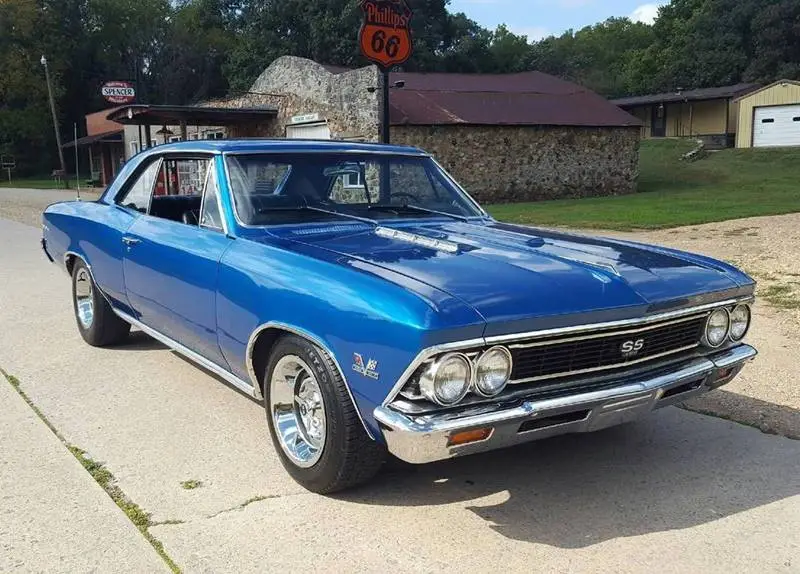
“Chevelle for ’66 is marked by a pleasing mid-size, overall excellence and value. Exclusive look for the new SS 396 series.” 1966 Chevelle brochure
- The Malibu Super Sport series became known as the SS 396, marketed to sports car enthusiasts with exclusive styling and three versions of the standard 396 cubic inch V-8.
- All the Chevelle models received a redesign with sleeker lines, though the change resulted in only a slightly longer length at 197 inches (the wagons shrunk slightly to 199.9 inches)
- Along with the Corvair and Corvette, the Chevelle was one of the few Chevrolet models not to see production decreases in 1966 (there were 412,000 Chevelles produced that year)
Muscle Car Specifications
Chevrolet responded once again to the ever-growing popularity of mid-sized cars with large engines by issuing the SS 396 exclusively with a large block V-8. While the rest of the Chevelle models retained the same standard engine (194 cubic inch six cylinder or 283 cubic inch V-8) and upgrade options(230 cubic inch six cylinder or 327 cubic inch V-8) they had contained since the 1964 introduction, every model in every series had the option to include the 396 cubic inch V-8 known as the Turbo-Jet. Additionally, all engine options were available with the choice of automatic or manual transmissions for the first time.
Chevelle 300 and 300 DeLuxe
Other than the redesigns present in every Chevelle model for 1966, the 300 and 300 DeLuxe remained relatively unchanged in their bare-bone offerings for the Chevelle line. The DeLuxe continued the tradition of offering slightly more options (interior color, more expressive trim) than its cheaper 300 counterpart. Both offered the same models offered in 1965, a 2- and 4-Door sedan for both, while the DeLuxe had the added option of a 4-Door wagon.
Malibu
The Malibu continued its reign as the leading seller of the Chevelle in 1966, with a production run of 241,600. It’s general appeal came not only in its inclusion of a multitude of upgraded standard options, but also because it boasted the highest number of model options, with the 4-door sport sedan, 2-door sport coupe, convertible, 4-door sedan and 2-seat station wagon.
As with previous models, the Malibu’s interior consisted of standard upgrades such as deep-twist carpet and all vinyl interiors. Additionally, it offered a wider range of interior and exterior color options.
Super Sport 396
Capitalizing on the growing popularity of the muscle car, Chevy took the Malibu tag off the SS and simply called it the Chevelle SS 396. This, of course, resulted from the 396 cubic inch engine that came standard with the SS. The base engine produced 325 horsepower, and an optional upgrade known as the L34 that could produce 360 horsepower. The L34 had a taller cam, larger four-barrel and a stronger block.
Additionally, the SS boasted the most luxurious standard interior options, as well as other features such as dual exhaust, sport wheel covers, a tachometer and, what became known as a signature of the Chevelle SS, two simulated scoops.
With all of these features, coupled with a relatively low $2,776 base price, the SS represented a quick, sporty car that was still great for daily use. It was a third engine option that really appealed to budding muscle car enthusiasts, the L78 396, which was also a 396 cubic inch V-8, but boasted a 375 horsepower rating and closely resembled the 1965 Z-16 package.
Though the L78 was produced throughout the 1966 model year, Chevrolet’s early marketing materials did not mention the third engine option. According to dealers at the time, Chevy considered the powerful engine directed more toward racing activities than everyday use. Therefore, only about 3,100 of the L78 models were built, and became more popular as the model year progressed.
Muscle Car Competition
Though relatively few of the most powerful L78 engines were built in 1966, they foreshadowed Chevrolet’s still strong interest in joining the muscle car competition with Ford, the Pontiac GTO and the Dodge Charger, among others. Keeping the Chevelle at a lower price than the competition (specifically Buick and Oldsmobile) attracted a large number of buyers interested in muscle car performance on a budget. While not as luxurious as some of their counterparts at other companies, the early Chevelles provided the template for the car’s future prominence as a sleek yet affordable performance machine.
Changes were minor for the 1967 Chevelle and mostly limited to styling touches and a few changes in the engine lineup. The aggressiveness of the front fenders was toned down a bit, the grill now had wider horizontal slots and the headlights were spaced a little farther apart than they were in the 1966.
Engine Specifications
| Type | Size | Carb | Horse Power | Tourqe |
|---|---|---|---|---|
| I6 | 194ci | 1x1bbl | 120 hp @ 4400 rpm | 177 lb-ft @ 2400 rpm |
| I6 | 230ci | 1x1bbl | 140 hp @ 4400 rpm | 220 lb-ft @ 1600 rpm |
| V8 | 283ci | 1x4bbl | 220 hp @ 4400 rpm | 295 lb-ft @ 3200 rpm |
| V8 | 283ci | 1x2bbl | 195 hp @ 4800 rpm | 285 lb-ft @ 2400 rpm |
| V8 | 327ci | 1x4bbl | 275 hp @ 4800 rpm | 355 lb-ft @ 3200 rpm |
| V8 | 396ci | 1x4bbl | 375 hp @ 5600 rpm | 415 lb-ft @ 3600 rpm |
| V8 | 396ci | 1x4bbl | 360 hp @ 5200 rpm | 420 lb-ft @ 3600 rpm |
| V8 | 396ci | 1x4bbl | 325 hp @ 4800 rpm | 410 lb-ft @ 3200 rpm |
Performance Statistics
| 0 to 60 mph | Quarter Mile | Engine | Source |
|---|---|---|---|
| n/a | 15.0 sec @ 97.8 mph | 396ci/375hp | Car Craft |
| n/a | 14.4 sec @ 100.2 mph | 396ci/360hp | PopularHot Rod |
| 6.0 sec | 14.7 sec @ 99.9 mph | 396ci/360hp | Car & Driver 3/66 |
The 1966 Chevelle was GMs best car in 1966
What a change one year makes. The square hard lines on 1965 Chevelle were replaced with the much softer and curvier lines. The improvements were noticeable. At the time, the press compared it to the classic 1955 Chevy. The Chevelle was taking the GTOs place as GMs best muscle car.












